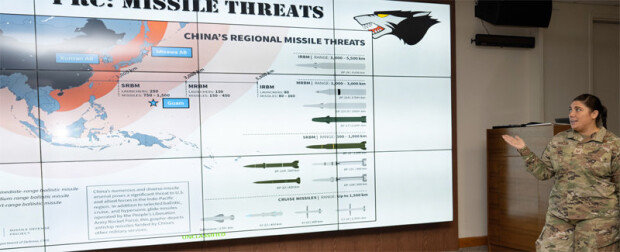U.S. Air Force in S. Korea assesses Chinese missile threats
U.S. Air Force in S. Korea assesses Chinese missile threats
Posted May. 15, 2024 07:48,
Updated May. 15, 2024 07:48

A subordinate unit of the U.S. 7th Air Force in South Korea has released details of a briefing on Chinese missile threats targeting U.S. bases in South Korea and Japan and the artificial islands constructed by China in the South China Sea. The decision to disclose information on Chinese missile threats during a preliminary briefing for readiness exercises earlier this month underscores the gravity of China's military capabilities amidst escalating tensions with the U.S. Observers note that this move by the U.S. military aims to incorporate this perceived threat into future exercise scenarios.
The U.S. 7th Air Force recently disclosed several photos on its website from a training briefing conducted by the 8th Fighter Wing at Gunsan Air Base in South Jeolla Province on May 2. This briefing, part of preparations for the May 6-10 Base-wide Readiness Exercise, featured the unit's intelligence assessment of military developments on the Korean Peninsula and the broader region.
In a photo, an intelligence officer and troops are captured, briefing commanders with a large screen entitled "China's Regional Missile Threat," outlining the ranges of China's major ballistic and cruise missiles. Text displayed at the bottom of the screen emphasized that China's expansive missile arsenal, encompassing ballistic, cruise, hypersonic, and anti-ship missiles, poses a significant threat to U.S. and allied forces in the Indo-Pacific region.
Of particular concern were China's short-range ballistic missiles (SRBMs) within range of U.S. bases in Gunsan, South Korea, and Misawa, Japan, and intermediate-range ballistic missiles (MRBMs) capable of targeting Guam. The briefing also highlighted the location and provided photographs of seven concrete artificial islands constructed by China within its unilaterally claimed nine-dash line in the South China Sea.
Sang-Ho Yun ysh1005@donga.com







